Rank Species | ||
 | ||
Similar Cnephasia, Cnephasia communana, Cnephasia incertana, Cnephasia asseclana, Acleris rhombana | ||
Cnephasia longana, the omnivorous leaftier moth, long-winged shade or strawberry fruitworm, is a moth of the family Tortricidae. It was described by Haworth in 1811. It is native to western Europe (where it is found from Scandinavia to the Iberian Peninsula, Sardinia, Sicily and Crete and from Ireland to Poland). It is an introduced species in western North America (where it is found in southern British Columbia, Washington, Oregon and California). The species has also been reported from north-western Africa and Asia. The habitat consists of downland and rough ground.
The length of the forewings is 7.5-10.8 mm. Adults are sexually dimorphic. Males have uniform white to yellowish-brown forewings. Females are marked with light to dark brown. Adults are on wing from late March to early July in California and from July to August in western Europe.
The larvae feed on a wide range of herbaceous plants, including Asteraceae, Convolvulaceae, Fabaceae, Geraniaceae, Hydrophyllaceae, Linaceae, Papaveraceae, Polygonaceae, Rosaceae, Scrophulariaceae and Violaceae species. It is considered a pest on cereal crops. First instar larvae hibernate in cracks or crevices in bark. In spring, larvae initially mine the leaves of their host plant. The mine has the form of an irregular, small, full-depth corridor, widening into a blotch. Later, they web the terminal parts of the host and may also bore into fruit. Full-grown larvae have a greenish brown or yellowish green body and pale brown head. They reach a length of 14–18 mm.
